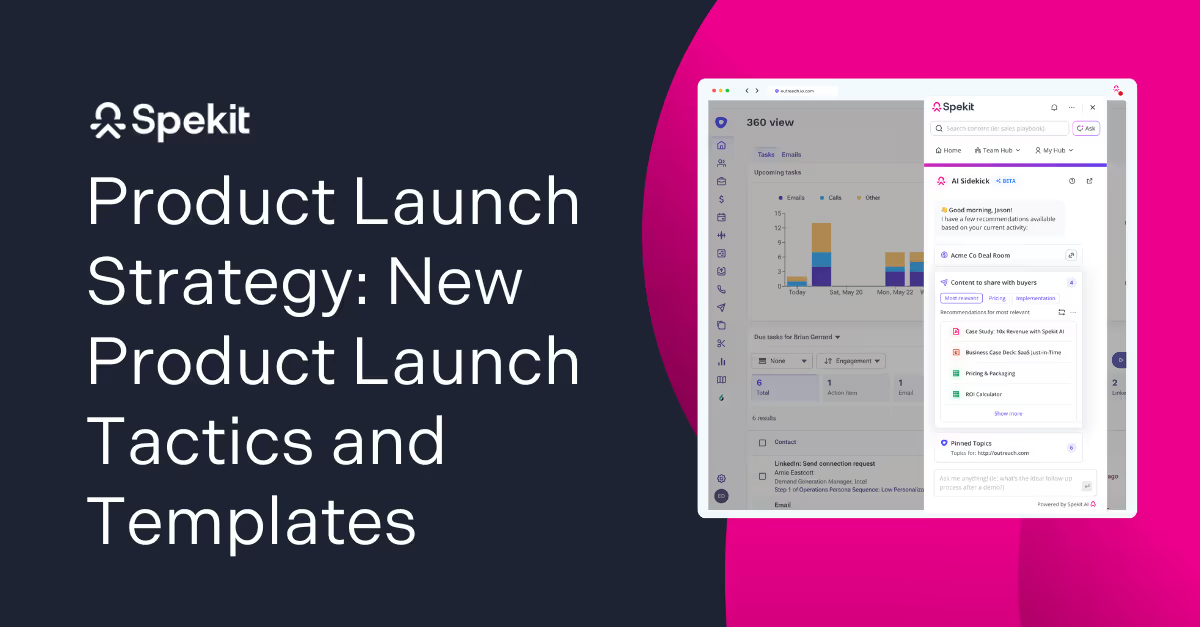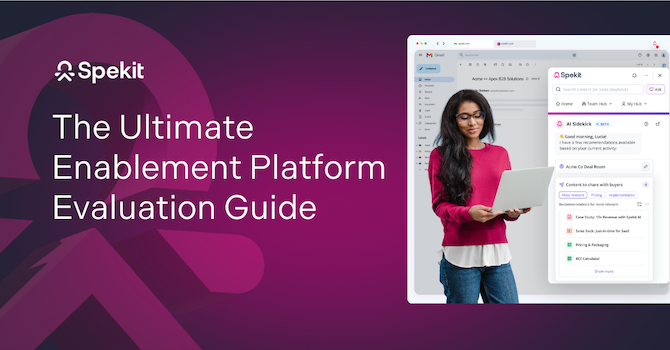It’s the week of your big product launch, and everything feels last-minute. You’re scrambling to finalize messaging, chasing down reviews from beta testers, and fielding questions from different teams.
Leadership wants to know if the deck is ready, the Sales team wants a talk track, and the Support team just heard about the launch yesterday.
You’ve been working hard, but somehow, you’re behind. Content? Scattered. Timelines? Unclear. Teams across the org? They aren’t sure what to say or where to find what they need.
This is what happens without a clear, repeatable launch process.
In this article, we're gonna give you exactly that: an 8-step plan designed to bring structure and clarity to your product launch.
This repeatable framework will help you:
- Align teams
- Deliver the right content at the right time
- And drive product adoption
Let's dive in.
How to successfully launch a new product in 8 steps
Here's a quick summary of the steps we run through in this article:
Note: If you don’t have a dedicated Product Marketing Manager or Product team, ownership of the launch plan typically falls to the Content Marketing or Growth Marketing team, especially those closest to messaging, customer education, and GTM campaigns.
Step 1: Create your product launch strategy and design your launch roadmap
Complete: 4–6 weeks out from launch
Owned by: Product Marketing Manager (PMM)
Other roles involved: Product, Sales, Enablement, RevOps, Customer Success, Marketing
This is your North Star for the entire launch. At this stage, you’re defining what success looks like and building a roadmap to achieve it. That means setting clear launch goals (adoption, revenue, awareness—whatever matters most), choosing your rollout strategy, locking in timelines, and aligning with existing GTM or sales motions.
What ‘good’ looks like at this stage:
- A clear launch objective tied to a business goal (e.g., “increase free-to-paid conversion by 20%,” not “get more people to use the product”).
- A phased rollout plan broken into pre-launch, launch, and post-launch.
- Cross-functional buy-in and understanding of who owns what.
- Clear timeline with milestones and dependencies mapped out.
- Launch formats and channels selected based on audience behavior (email, in-app, enablement, webinars, etc.).
- A documented plan that can be shared and revisited.
Where teams go wrong:
- Setting vague goals like “increase adoption” with no metrics attached.
- Planning the launch in isolation, without input from Sales or Customer Success.
- Jumping into content creation before defining the launch strategy.
- Underestimating the time it takes to align stakeholders.
- Forgetting to connect the launch to broader GTM or company priorities.
What to include in your GTM plan
Your GTM plan is your launch blueprint. Here’s what to include:
- Timeline: Break your launch into phases—pre-launch (training, content prep), launch (announcement, rollout), post-launch (reinforcement, follow-ups). Specify the deadlines for each phase and add a buffer just in case things don’t go strictly to plan.
- Target audience: Who is this launch for? New users, existing customers, enterprise clients, or a mix of them? Each audience needs tailored messaging.
- Channels: Choose your launch/promotion channels based on where your target audience already is, e.g., email, in-app messages, Slack, LinkedIn, and webinars.
- Message pillars: Outline 2–3 core messages that explain what your new product/feature does and why your audience should care.
- Content and asset owners: Know who’s creating what and when—blog post, email sequence, sales deck, enablement doc, etc.
- Dependencies: Identify factors that could delay the launch, such as legal reviews, product localization, and quality assurance. Plan around them now, not later.
Deciding your budget: How much should a product launch cost?
According to the LaunchPad Agency, you should budget:
- Around $87,000 for a smaller-scale launch; and
- Over $535,000 for a more comprehensive, large-scale launch.
These prices include market research, product development, branding and positioning, content creation, launch events, and post-launch marketing.
As you can see, the range is wide. That’s because what you spend depends on your goals and scope.
A low-lift feature launch might only need internal enablement and a few blog posts. But a major product release launch could involve:
- Content creation: Tutorial videos, product demos, landing pages, webinars, sales decks, battlecards, etc.
- Paid promotion: Set aside money for ads, influencer marketing, or sponsored content.
- Internal enablement: Budget time and tools to train and support the Sales and Customer Success teams.
- Post-launch support: Consider feedback loops, follow-up campaigns, and content refreshes.
The takeaway: Align your budget to your goals. Whether it's revenue, market expansion, or awareness, spend based on the outcome you’re driving. And don’t forget to factor in post-launch support.
Step 2: Rally the troops (your key stakeholders)
Complete: 4–5 weeks out from launch
Owned by: Product Marketing Manager (PMM)
Other roles involved: Enablement, Sales, Customer Success, Product, RevOps, Marketing
With the launch plan drafted, it’s time to gather your internal stakeholders, review the plan, and make sure everyone understands their role in making it happen.
Bring teams together to:
- Review the launch strategy and timeline. Make sure everyone knows the phases and key milestones.
- Assign owners to deliverables. Think blog post (Content), demo deck (PMM), sales enablement (Enablement), in-app guide (Product), customer emails (CS/Marketing).
- Set deadlines and feedback loops. Establish who’s reviewing what and when.
- Align on channels and sequencing. Confirm who is messaging whom and in what order.
What ‘good’ looks like at this stage:
- All stakeholders have reviewed and signed off on the plan.
- Roles and deliverables are clearly defined, documented, and accepted.
- A central launch doc or tracker exists and is accessible to all involved.
- Review cycles are mapped, and timelines feel realistic.
- Everyone understands how their work ties back to the overall launch goal.
Where teams go wrong:
- Assuming everyone’s on board without getting explicit buy-in.
- Assigning tasks without setting clear deadlines or expectations.
- Skipping this step entirely and jumping straight into execution.
- Not involving Sales or CS early enough to shape messaging and delivery.
- Relying on scattered email threads instead of a central launch hub, like Slack or Asana.
Step 3: Decide what launch content you need
Complete: 3–4 weeks out from launch
Owned by: Product Marketing Manager (PMM)
Other roles involved: Enablement, Sales, CS, Product, Marketing, Support
Before teams can execute, they need content—specific, clear, and delivered in the right format, at the right time. That means deciding what to create, why, and for whom.
Start by identifying all your key audiences: Sales reps, Customer Success Managers (CSMs), support agents, and prospects/customers. Each one needs something slightly different. From there:
- List essential internal assets. These assets help your Sales and Customer Success teams sell the product and help customers, e.g., FAQs, demo scripts, enablement decks, talk tracks, objection-handling sheets, and internal training videos.
- List essential external assets. These assets help customers learn what your product does and how it can help them. Think blog posts, marketing emails, customer webinars, help docs, and social copy.
- List cross-channel assets. These include in-app messages, landing pages, banners, support macros, or LMS content—anything that spans multiple audiences.
- Define key messaging. Your value proposition should be crystal clear and tailored to each channel. What resonates in a launch email might not land in a CS enablement session.
What ‘good’ looks like at this stage:
- A content matrix organized by audience, format, and delivery date.
- Clear messaging pillars adapted for each asset.
- Content briefs written (or started) for key pieces.
- Owners and deadlines assigned to each deliverable.
- Visibility into where each asset will live (e.g., Spekit, CMS, sales hub)
Where teams go wrong:
- Focusing only on external assets and forgetting internal content like talk tracks or FAQs.
- Creating content without aligning on core messaging first.
- Not tailoring messaging/assets to the channel and audience.
- Leaving Sales and CS unsure of what to use, when, or where
- Waiting too long to start creating content, leading to last-minute bottlenecks.
Step 4: Create your product launch content
Complete: 2–3 weeks out from launch
Owned by: Product Marketing Manager (PMM)
Other roles involved: Content, Design, Enablement, Sales, CS, Product
With your content plan in place, it’s time to turn your briefs into polished assets that clearly communicate value, whether you're speaking to internal teams or customers. Every piece of content should have a clear purpose, be easy to consume, and be organized in one place for smooth collaboration.
Here’s what to do:
- Design content for clarity. Use clear headings, bullets, plain language, and visual elements to make your content easy to scan and understand. (Sort of how we wrote this how-to guide!).
- Match the tone to the audience. Use a conversational and straightforward tone for internal assets. And make sure that customer-facing content is polished, on-brand, and focused on how the product helps customers, not just what the features are.
- Centralize drafts and feedback. Use a shared document or tool (like Google Docs, Notion, or your CMS) for real-time reviews and comments. This streamlines feedback and prevents version chaos.
We like to use Google Docs and create document tabs for every draft we create. That way, you can easily revisit previous iterations and improvements.
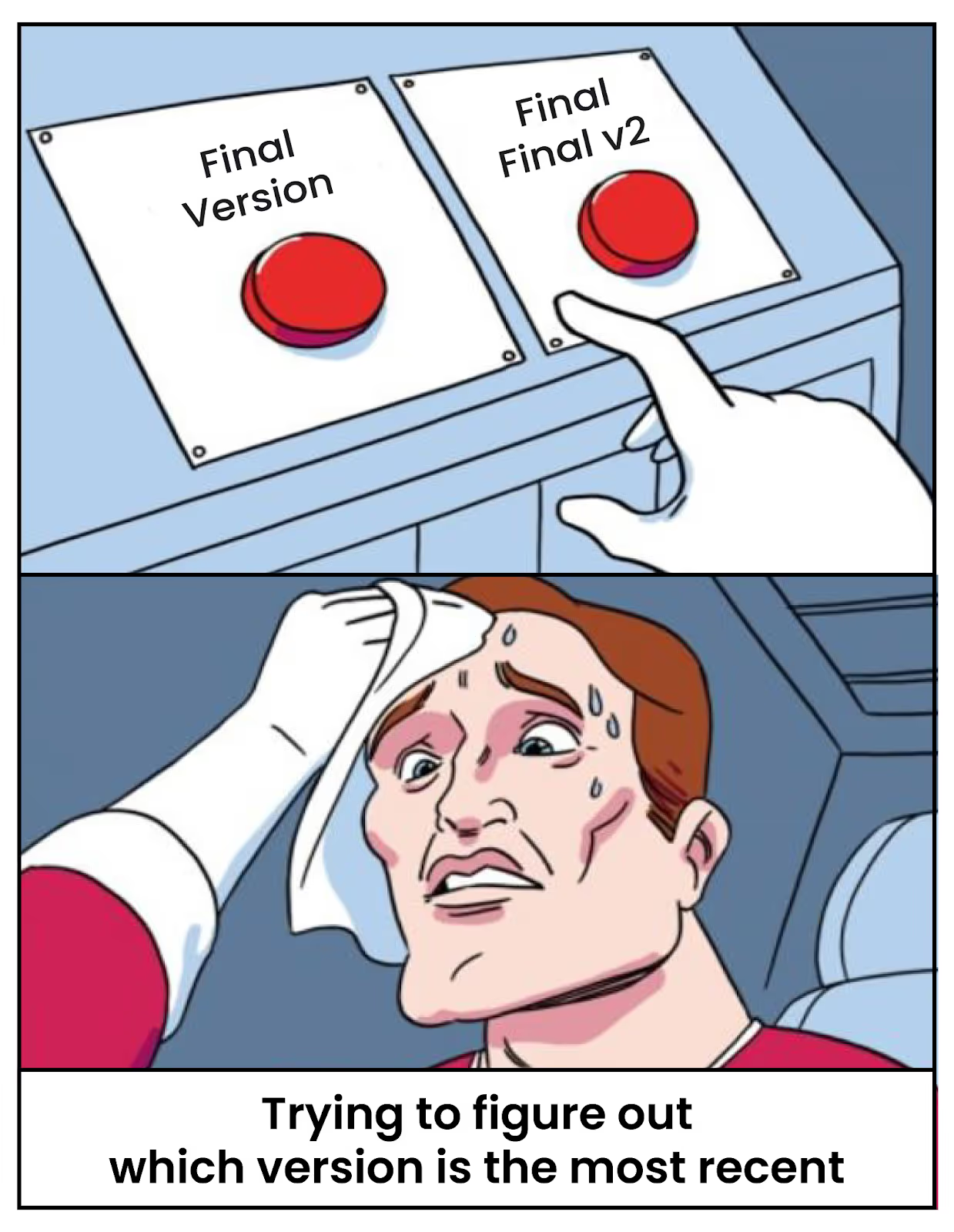
- Run a final QA pass. Double-check every asset for broken links, access permissions, formatting issues, brand consistency, and messaging alignment before moving to final delivery.
What ‘good’ looks like at this stage:
- Final copy and design for each asset are approved or near-ready.
- Drafts are centralized in one tool or folder with clear versioning.
- Feedback loops are fast and focused, and do not drag timelines.
- Messaging is consistent across all assets, with an audience-specific tone.
- All links, CTAs, and access settings have been tested and are working.
Where teams go wrong:
- Writing content in silos without cross-team input.
- Forgetting to double-check for broken links, typos, or incorrect information.
- Overwriting and over-designing assets that should be simple.
- Leaving Sales or CS reps unclear on where to find the final versions.
💡How Spekit can help
Creating content is only half the equation. The other half is making sure your customer-facing teams can actually find and use it.
If Sales or CS reps can’t access the right piece of information quickly, it slows down deals, delays support, and adds friction to the selling process.
Spekit eliminates this by surfacing product launch content directly within the tools your teams already use (like Gmail, LinkedIn, Slack, and Salesforce), so they don’t have to dig through folders or chase down links.
Instead, they get access to the exact content they need (in context), without breaking their flow. The result is faster answers, smoother handoffs, and better outcomes from the content you worked hard to create.
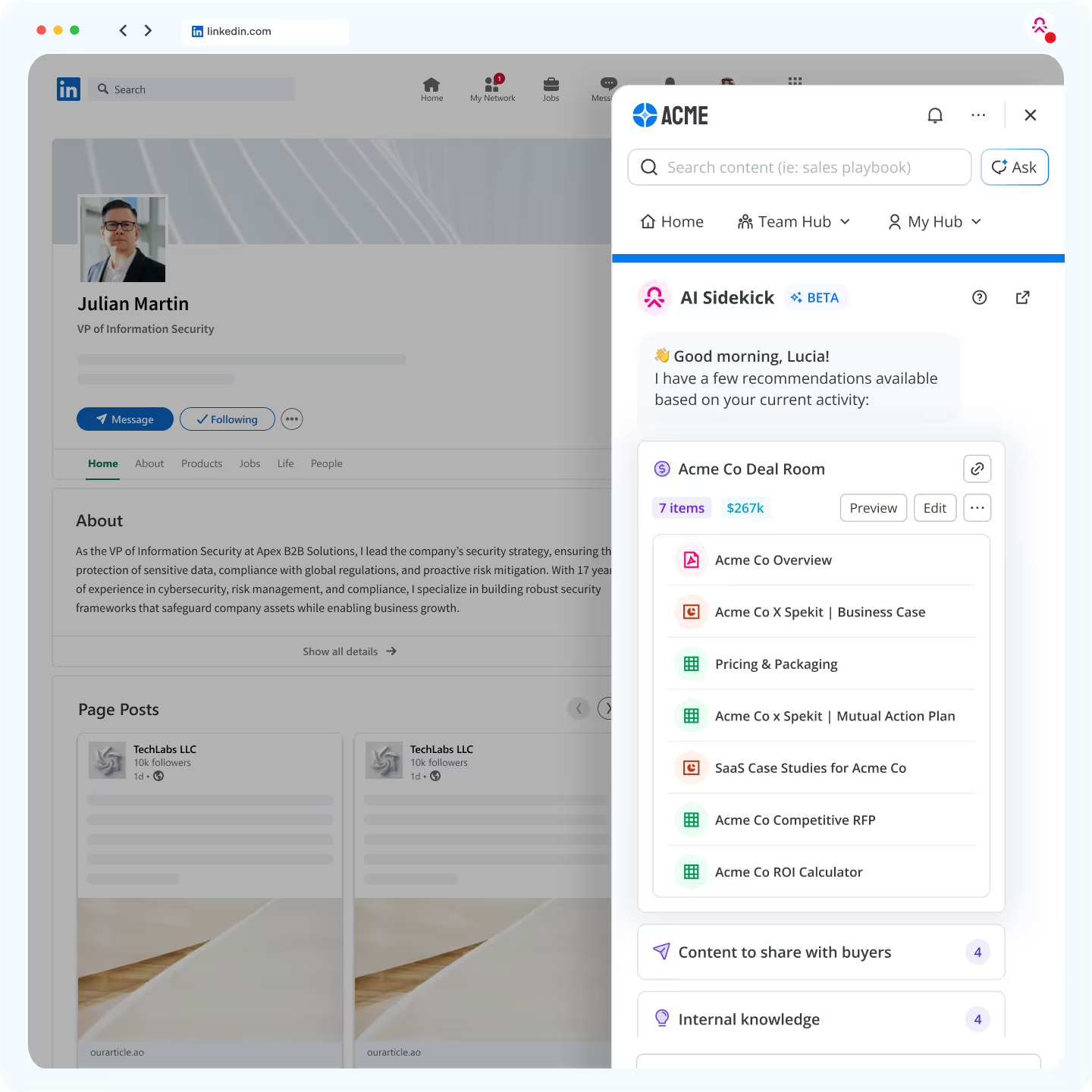
Read: Product Launch Content: Examples & Strategies to Nail a New Product Launch
Step 5: Train, reinforce, and embed product knowledge across the organization
Complete: 1–2 weeks out from launch
Owned by: Product Marketing Manager (PMM)
Other roles involved: Enablement, Sales Managers, CS Leaders, Product
To drive true adoption, product knowledge needs to be absorbed, reinforced, and easily accessible at every stage of the customer journey.
Here’s how to implement that:
- Run live enablement sessions. Host a focused training for Sales, CS, and Support teams with a clear agenda, demo, and time for Q&A.
- Offer asynchronous options. Record your sessions and pair them with short video walkthroughs or bite-sized explainers for those who can’t attend live.
- Create a centralized knowledge hub. Share all decks, FAQs, talk tracks, and recordings in a single location (e.g., Google Drive or Notion) and pin them in team Slack channels.
- Embed training in the flow of work. With Spekit, reps can find contextual guidance directly within tools like Salesforce, Slack, and Gong, without needing to search or switch tabs.
- Use knowledge checks to reinforce learning. With Spekit, you can quickly create short assessments (called Knowledge Checks) to measure reps’ understanding and help key product details stick.
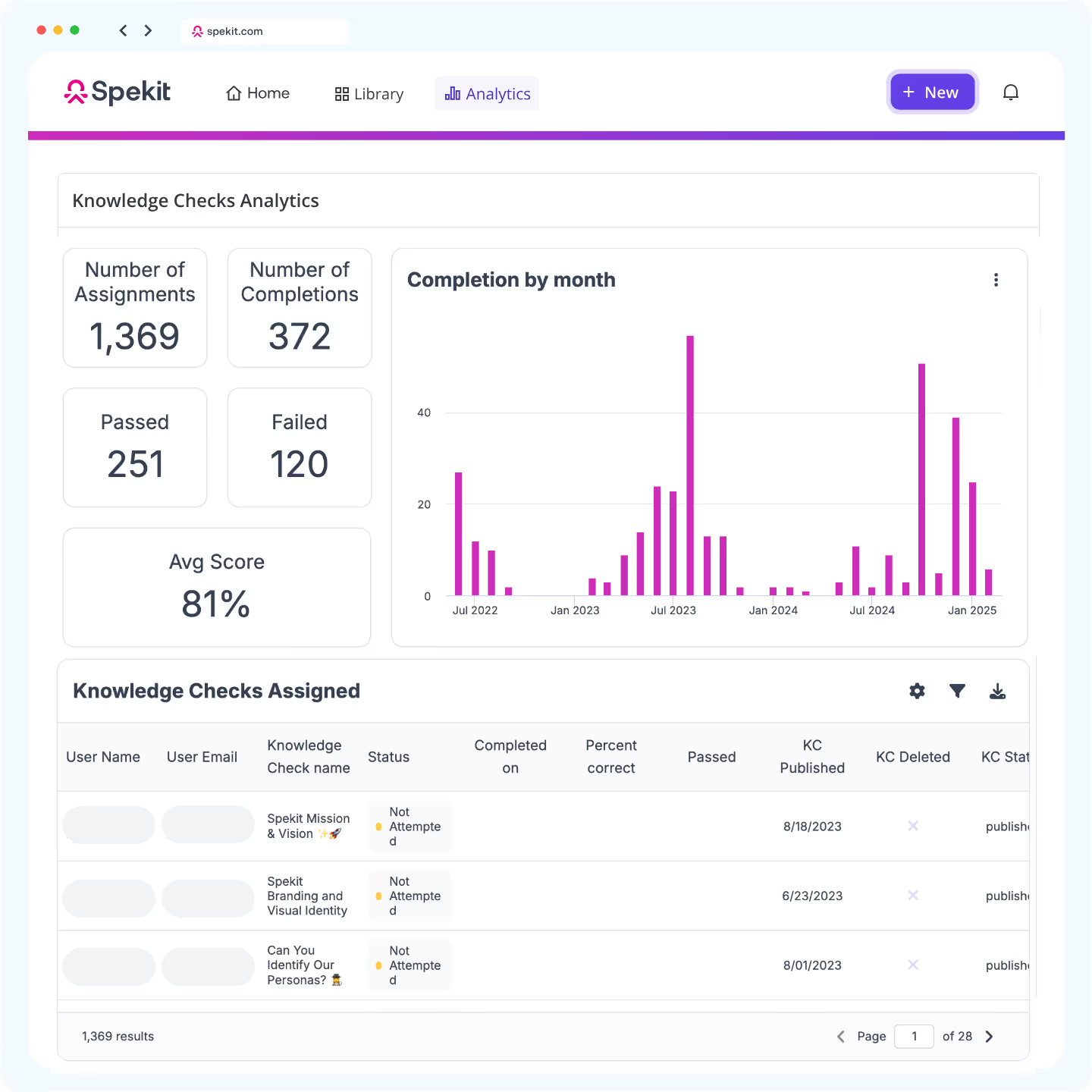
- Send internal alerts. Use Spekit Spotlights to push launch updates, feature reminders, or key positioning right where teams will see it.
What ‘good’ looks like at this stage:
- All customer-facing teams are trained and know where to find key resources.
- Internal content is accessible across channels and tools.
- Messaging is consistent across teams and aligned with launch goals.
- Knowledge checks show solid understanding of the product and use cases.
- Sales and CS teams feel confident answering customer questions.
Where teams go wrong:
- Treating sales enablement as a one-time meeting, with no follow-up.
- Delivering training too close to launch, giving teams no time to prepare.
- Failing to make content accessible after the session ends.
- Ignoring the value of async options for distributed or busy teams.
- Skipping in-context reinforcement, leading to poor retention and mixed messaging.
Live training vs. in-context reinforcement
Live training is ideal for building excitement, demonstrating the product in real-time, and getting everyone on the same page quickly. Think structured sessions, interactive Q&A, or team-wide kickoff calls led by the PMM or, if you have one, an Enablement or Sales leader.
However, training doesn’t stop at a one-time session.
In-context reinforcement is what keeps that knowledge alive. It means surfacing the right content—FAQs, talk tracks, feature reminders—exactly where teams are working.
With Spekit, that looks like a sales rep getting positioning tips right inside Salesforce, or a CSM seeing the latest updates in Slack or Gong. No switching tabs, no digging around. Just the right info at the right moment.
This combination of live and embedded enablement helps your launch content stick and keeps your teams ready long after day one.
Read: Best Knowledge Management & Sales Enablement Software: Spekit vs Guru
Step 6: Tease your product launch to create anticipation and excitement
Complete: 1–2 weeks out from launch
Owned by: Product Marketing Manager (PMM)
Other roles involved: Marketing, Comms, Enablement, Customer Success
Launch day shouldn’t be the first time people hear about your product. In the final stretch before release, start building anticipation, both internally and externally. This warms up your audiences, sparks curiosity, and primes your customers for what’s ahead.
However, remember that the launch isn’t about your product. It’s about your users and what they’ll be able to do because of it. Your teaser strategy should reflect that.
Here’s how to build anticipation:
- Send internal hype emails or Slack countdowns. Keep internal teams excited and ready with fun updates, sneak peeks, or “X days to go” messages.
- Run external teaser campaigns. Use social posts, email drips, or light website banners to hint at what’s coming.
- Share preview content or early access incentives. Give priority customers or top accounts a first look, a private beta, or a behind-the-scenes webinar.
- Align teaser language with your value prop. Don’t just say, “Something new is coming.” Say, “Here’s what you’ll be able to do that you couldn’t before.”
Pro tip:
For B2B products with longer sales cycles, your Sales team should start teasing the launch 2-4 weeks before your official teaser campaign kicks off. Arm reps with soft language like, “We have something in the works that will make X easier for you…” or “We’ve been listening to your feedback, and our next product update is a direct response to that.” This helps build interest without overpromising or jumping the gun.
What ‘good’ looks like at this stage:
- Internal teams are aligned, aware of what’s coming, and actively engaging with pre-launch content.
- Customers are curious and ready to learn more about the new product.
- Teaser messaging is consistent, benefit-driven, and clearly tied to user outcomes.
- Previews or early access programs are in place and scoped for key audiences or accounts.
- Teaser campaigns are tailored to each channel and audience.
Where teams go wrong:
- Launching the product with no buildup or awareness beforehand.
- Using vague or generic messaging that doesn’t tie back to user needs or value.
- Not talking about the launch enough. Most people won’t see every post or email, so share multiple messages to keep it top of mind.
- Leaving Sales and Customer Success out of teaser planning.
- Relying on one channel (like email or social) for the teaser campaign, instead of meeting users where they are across multiple touchpoints.
- Forgetting to track engagement or reactions to teaser content, missing early signals about message clarity, or audience interest.
Step 7: Launch!
Complete: Launch day
Owned by: Product Marketing Manager (PMM)
Other roles involved: Marketing, Enablement, Customer Success, Sales, Support
Launch day is go-time. Announcements go live, assets are activated, and your internal teams are ready to engage. But launching is as much about pushing content out as it is making sure every audience hears a consistent, coordinated message and knows what action to take.
Here’s what to focus on:
- Sync internal and external messaging. Your blog, emails, and in-app updates should align with what Sales and CS are saying.
- Activate key comms. Publish your blog post, update help docs, send launch emails, and go live with landing pages or product tours.
- Equip Sales and CS with follow-up playbooks. Include talk tracks, objection handlers, battlecards, and key outcomes to focus on.
- Reinforce access to enablement content. Customer questions will come quickly, so make sure Sales and CS reps can find what they need.
With Spekit, you don’t have to worry about reps scrambling for answers. Spekit surfaces launch assets directly in tools like Salesforce, Gmail, and Slack, so reps have real-time answers at their fingertips.
What ‘good’ looks like at this stage:
- Launch messaging is consistent across all channels and teams.
- All assets are live, tested, and easy to access.
- Sales and CS reps feel confident, prepared, and equipped for conversations.
- Teams are actively engaging with Spekit (or your enablement hub).
- Metrics tracking is in place (e.g., clicks, opens, usage, engagement).
Where teams go wrong:
- Launching content without aligning internal teams on key messages.
- Forgetting to notify internal teams that assets are live and ready.
- Skipping post-launch follow-up plans for Sales or CS teams.
- Failing to monitor asset usage or rep engagement.
- Treating launch day as the finish line instead of the starting point for adoption.
Step 8: Monitor and review
Complete: Right after launch (and ongoing)
Owned by: Product Marketing Manager (PMM)
Other roles involved: Enablement, Sales, CS, Marketing, Product
The launch may be over, but the work isn’t. Now it’s time to assess what worked, what didn’t, and what needs follow-up.
Start by reviewing usage data, gathering team insights, and assessing the performance of your launch assets. Update or replace anything that missed the mark. Then document what you’ve learned to plan your next round of training or product education.
The goal is to keep improving—not just the product itself, but the way you promote it moving forward.
What ‘good’ looks like at this stage:
- Content engagement is being tracked across internal and external assets.
- Sales and CS are actively using the materials and giving useful feedback.
- A post-launch review has been held, documented, and shared across teams.
- Underused or confusing content is updated, archived, or reworked.
- Clear next steps or follow-up initiatives are planned and documented.
Where teams go wrong:
- Failing to track content usage, so there’s no visibility into what’s working (and what isn’t).
- Gathering feedback but not acting on it or sharing outcomes.
- Letting momentum die after launch day, with no follow-up plans.
- Holding a post-launch review too late—or skipping it entirely.
- Focusing only on metrics and ignoring qualitative insights from internal and external stakeholders.
What to track post-launch
Tracking post-launch metrics helps you understand whether your content and messaging actually landed, and where your teams may still need support.
Start with:
- Spekit analytics: See which content was viewed, by whom, and how often. If certain assets weren’t used, that’s a flag to revisit the format, placement, clarity, or relevance.
- Email and blog performance: Open and click rates can reveal which messages resonated.
- In-app engagement: Are customers discovering new features? Are they adopting and getting value from the product?
- Support and CS trends: Are customer queries decreasing over time? Or are the same issues coming up repeatedly?
Tracking is only useful if it leads to action. Use this data to fine-tune your enablement, reinforce your messaging, and better prepare for the next rollout.
How to gather and apply feedback
Don’t wait for feedback to trickle in—go get it. Set up short surveys or quick 1:1s with Sales, CS, and Support to hear firsthand how the launch felt on the ground. Ask what was helpful, what was missing, and what they heard from customers.
You can also create a shared doc or Slack thread to collect running feedback. And if you're using Spekit, track content performance directly and follow up with specific teams based on what they’re engaging with, or ignoring.
After you’ve gathered insights, run a brief post-mortem. Share what worked, where things broke down, and what you'd do differently next time. Keep it honest, but constructive. Then use those insights to plan follow-up campaigns, refresh outdated content, and build stronger habits into your next launch cycle.
Taking this step-by-step framework into the real world
No two launches look exactly the same, but the best ones follow a clear process. Use this framework as your foundation. Stay organized, keep tasks and timelines visible, and adjust based on your team’s needs.
When things feel messy, come back to the basics: What are we launching? Who are we targeting? And what do they need to achieve their goals?
To make this process work at scale, you need more than a plan—you need a system.
Spekit brings your launch content to life by delivering it exactly where teams need it, whether that’s in Salesforce, Slack, or LinkedIn. It helps reinforce your messaging, reduces confusion, and ensures the content you worked hard to create is actually used.
Want to learn how Spekit works? Book a demo today.

